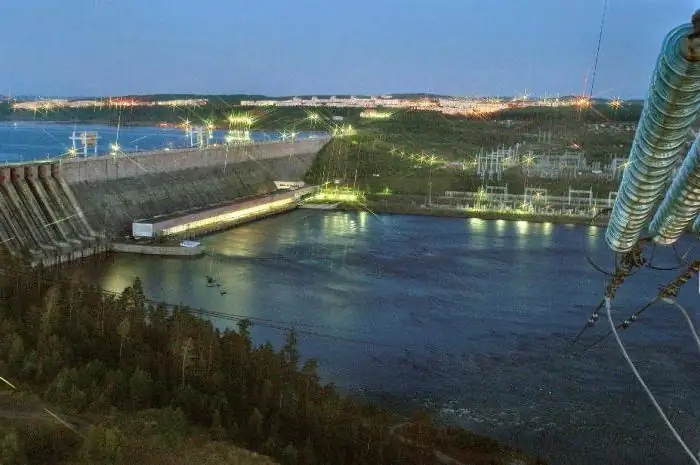2026 Author: Howard Calhoun | [email protected]. Last modified: 2025-01-24 13:10:38
Nizhnekamskaya HPP in Tatarstan is a unique and the only energy enterprise in the republic connected to the UES of Russia. Thanks to this enterprise, which is part of the Tatenergo holding, the residents of the region are uninterruptedly supplied with electricity.

General information
Nizhnekamsk run-of-river HPP is located on the territory of the Republic of Tatarstan on the Kama River near Yelabuga and Naberezhnye Chelny. The construction of the power plant began in 1963, and it began to work only in 1979. HPP facilities include:
- concrete weir dam;
- channel dam;
- floodplain dams;
- gateways;
- hydroelectric building.
The maximum height of the floodplain and channel dam is 30 m and the total length is 2,976 km. Railway and motor roads are located directly on the dam. On average, more than 2 billion kWh of electricity is generated during the year.
After the erection of retaining structures, the Nizhnekamsk reservoir was formed. At the moment, the FSL is 63.3 m. Raising the level will allow generating more electricity, but it has been lobbied for several decades by the authorities of neighboring regions.
Construction history
Nizhnekamskaya HPP began to operate in 1979, when the filling level of the reservoir reached 62 m. This level is the minimum allowable, since it is it that ensures the operation of the HPP and the passage of ships through the locks. The reservoir flooded 78,000 hectares of nearby land, but 173,000 hectares were initially allocated for the construction of a hydroelectric power station on the territory of the republics of Tatarstan, Bashkortostan, Udmurtia and the Perm region. Prior to the flooding of the adjacent territories, work was carried out on deforestation, resettlement of local residents, transfer of infrastructure facilities and communications. The last (16th in a row) power unit was launched in 1987. By 1990, the management of the hydroelectric complex planned to raise the level of the reservoir to 68 m, which caused a wave of protests from various environmental organizations. Thus, the level was not raised. Up to the level of 63.5 m FSL was raised only in 2002 on the basis of a joint agreement between four regions.

Problems related to rising reservoir levels
According to the project documentation, the level should be at around 68 m. However, now it is intermediate, which provoked a number of problems in terms of ecology and economy. Since the Nizhnekamsk hydroelectric power station produces less electricity, navigation is difficult, and protective engineering structures have begun to collapse. ToIn addition, water blooms are observed from year to year. 50% of the reservoir area is shallow (depth does not reach 2 m), which is contrary to sanitary standards. If the level is raised to 68 m, a large number of areas in the surrounding regions will be flooded.
Accident
In 2010, an explosion occurred at the Nizhnekamsk hydroelectric power station, which was preceded by smoke. As a result, 2 employees of the enterprise were killed, 10 were injured. The source of the explosion was a damaged synchronous compressor that takes air for the needs of the power plant. The cause was an oil leak, which subsequently heated up and mixed with air. However, the accident did not affect the work of the enterprise.

The only power plant in Tatarstan is the Nizhnekamsk HPP. Naberezhnye Chelny and Yelabuga are the nearest settlements to it. The hydroelectric power station began operating in 1979, but so far it has not reached its design capacity. This is due to the fact that the level of the reservoir, according to the plan, should reach 68 m, but now it is at around 63.5 m. The Nizhnekamsk HPP is connected to the Unified Energy System of the Russian Federation and is economically important for the region.
Recommended:
What is the information business? Information business from A to Z

Today, the information business is deservedly considered the leading resource for the development of society. Let us consider in detail how and on what basis this activity is based
Krasnoyarsk HPP: the history of construction

Immediately after the Great Patriotic War, it became clear that the country needed a huge amount of electricity to restore its potential. This was especially true of Siberia, where hundreds of factories and enterprises were evacuated in 41-42 years of the last century
Volgograd HPP: general information

Volzhskaya HPP is the largest water power plant in the European part of Russia. Currently, it is part of the RusHydro Corporation as a branch. This grandiose building is located between the Traktorozavodsky district of Volgograd and its satellite city called Volzhsky. This HPP belongs to the group of medium-pressure run-of-river stations
Irkutsk HPP: construction, history, photo

The Irkutsk HPP is the very first and largest hydroelectric power plant built on the Angara. It laid the foundation for the formation of a whole energy complex. Difficulties in its construction helped to gain a truly invaluable experience
HPP Ust-Ilimskaya: photo, address. Construction of the Ust-Ilimskaya HPP

In the Irkutsk region, on the Angara River, there is one of the few hydroelectric power plants in the country that has paid for itself even before construction was completed. This is the Ust-Ilimskaya HPP, the third stage in the cascade of stations on the Angara

